Bandhani Sarees: Knots of Culture, Threads of Elegance
The world of Indian textiles is rich and diverse, showcasing a kaleidoscope of traditions and craftsmanship. Among the myriad of traditional handwoven sarees, bandhani sarees stand out as a testament to India’s intricate artistry and cultural heritage. Rooted in centuries-old traditions, these sarees have transcended time, preserving the essence of a bygone era while continuing to captivate contemporary fashion enthusiasts.
The Craftsmanship: A Symphony of Ties and Dyes
Bandhani sarees are a result of meticulous craftsmanship that requires skill, patience, and precision. Artisans start by tying thousands of tiny knots on the fabric using fine threads. The thing is done so that when the fabric is dyed, the tied portions resist the color, creating mesmerizing patterns. The process is labor-intensive and demands a keen eye for detail, making each Rajasthani tie-dye saree a unique piece of wearable art.
Dyeing Traditions: A Palette of Colors
The vibrant hues of traditional Indian-tied sarees are achieved through dyeing. The tied fabric is immersed in vibrant dyes, each knot resisting the color and creating a striking contrast. The colour palette of Rajasthani tie-dye sarees is diverse, ranging from vivid reds and blues to earthy tones and pastels. The choice of colors often holds cultural significance, with certain shades being favored during auspicious occasions and celebrations.
Regional Variations: A Cultural Mosaic
While the roots of Bandhani lie in Gujarat and Rajasthan, different regions have developed their unique variations of the craft. The Bandhani of Jamnagar is known for its fine detailing, with craftsmen often tying knots so closely that the fabric appears almost solid. In Kutch, the artisans experiment with geometric patterns and bold colours, creating a distinctive style that reflects the region’s nomadic heritage. The regional diversity in Bandhani patterns adds cultural depth to these exquisite sarees.
Cultural Significance: Beyond Fashion
Bandhani sarees online are more than just garments; they are carriers of cultural narratives and traditions. These sarees are deeply ingrained in India’s social fabric and are worn during significant ceremonies and celebrations. Bandhani is often associated with weddings, where brides don these vibrant sarees as a symbol of auspicious beginnings. The intricate patterns on these traditional Indian-tied sarees also hold symbolic meanings, with certain motifs representing prosperity, fertility, and good luck.
Revival in Modern Fashion: A Timeless Trend
In recent years, Rajasthani tie-dye sarees have experienced a resurgence in popularity, not only in India but also on the global fashion stage. Designers and fashion enthusiasts alike are drawn to the timeless elegance and traditional craftsmanship of Bandhani. The adaptability of Bandhani patterns to contemporary styles has led to a fusion of tradition and modernity, making these sarees a coveted choice for special occasions and high-profile events.
Sustainable Fashion: Bandhani in the 21st Century
As the world embraces sustainable practices, the traditional Indian-tied saree aligns perfectly with the ethos of eco-friendly fashion. The handcrafted nature of Bandhani ensures that each piece is a product of skillful artistry rather than mass production. Additionally, using natural dyes in the process adds an environmentally conscious dimension to these sarees. In a world increasingly concerned with the ecological impact of fashion, Bandhani emerges as a sustainable and ethical choice for those seeking both style and substance.
In conclusion, in a world where fast fashion often overshadows the significance of cultural heritage, bandhani sarees stand as a beacon of tradition, craftsmanship, and timeless beauty. Bandhani has traversed a remarkable journey from the ancient art of tying and dyeing to the modern runways. As the world celebrates the allure of the Rajasthani tie-dye saree, also recognise the artisans who, with their skillful hands, weave stories of tradition and culture into each intricate knot, ensuring that the legacy of Bandhani continues to thrive for generations to come.




















